How to Grow Your Own Sweet Potatoes
Whoever said diamonds were a girl’s best friend never had a Nancy Hall sweet potato. Not just any sweet potato, mind you. A Nancy Hall is unlike any other sweet tater I’ve ever tasted.
A sweet potato is to a Nancy Hall like ice milk is to Hagen Daz, a rock is to a diamond, or a shovel is to a Caterpillar D-11.
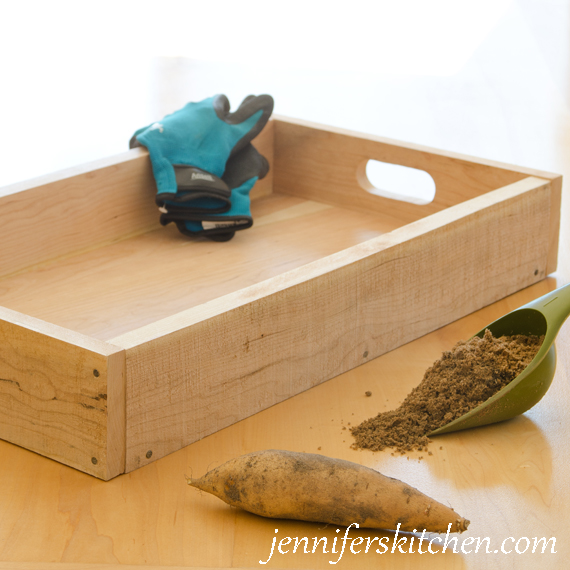
The sad thing is you won’t find a Nancy Hall in the grocery store. In fact, there are literally hundreds of varieties of sweet potatoes – in an amazing range of textures, colors, and flavors – that never show their pretty face in the average grocery store. If you’re fortunate, you may find a few varieties at your local farmer’s market, but if you want a particular variety when you want it, the best thing to do is grow your own!
Here’s How to Grow Your Own Sweet Potatoes
Unlike most other vegetables, sweet potatoes aren’t grown from seeds. Rather they are grown from “slips” that you either buy or start yourself and then plant into the ground when warm weather comes.
To grow your own sweet potato slips you’ll need at least one “starter” sweet potato.
Where do I Get a “Starter” Sweet Potato?
You can use any sweet potato as your starter sweet potato; however, conventionally-grown sweet potatoes are sometimes treated to prevent sprouting, so your best bet is to choose an organic one.
If you want to grow a variety that has more flavor than the plain-Jane, orange sweet potatoes found in grocery stores, you can use a sweet potato from last year’s garden, from a farmer’s market, or from a neighbor or friend who grows his/her own sweet potatoes.
Or come visit me and I’ll share a Nancy Hall with you.
What if I Can’t Find a Starter Sweet Potato?
If you can’t get your hands on a sweet potato, I recommend you buy sweet potato slips from a reputable grower this year, and then save a sweet potato or two from your harvest so you can grow your own slips next year.
How many starter sweet potatoes do I need?
That depends on how many sweet potato plants you want to grow. The average sweet potato produces about 25 slips – more or less depending on the variety.
How do I grow my own sweet potatoes?
About 4 weeks before last frost, take a healthy, mature, medium-size sweet potato and place in a container of sandy soil. It works best to lay the sweet potato horizontally in the soil. Cover with one to two inches of soil.
(You can also start sweet potato slips in water, but I use the soil method because it produces a hardier little plant.)
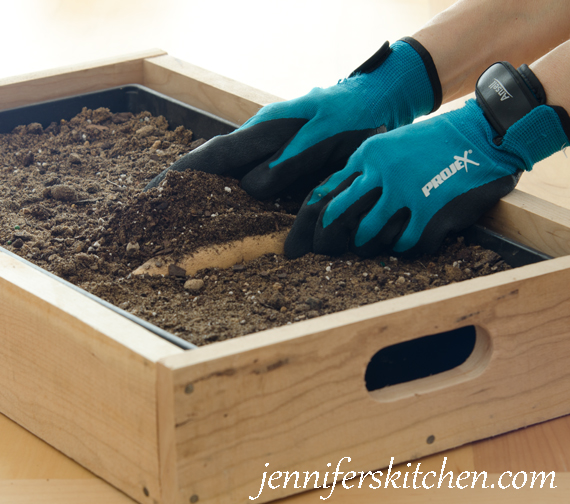
How do I run a high traffic site without ads? Some of my posts contain affiliate links. If you purchase anything through those links, your cost is the same, but I receive a small commission. Thank you for your help!
Moisten the soil. You want to keep the soil evenly moist but not wet.
Place in a very warm place, like by a wood stove, on a heating pad, or on a seed-starting heat mat. After a couple weeks you should see sprouts starting to emerge from the soil.

Getting Ready to Plant in Garden
When the sprouts are 6 to 8 inches tall and the weather outside is warm, start hardening off the sprouts by placing them outside in a partially shady spot for a few hours. Gradually increase outside time by 30 minutes to an hour every day, until they are capable of handling full sun without getting sunburned.
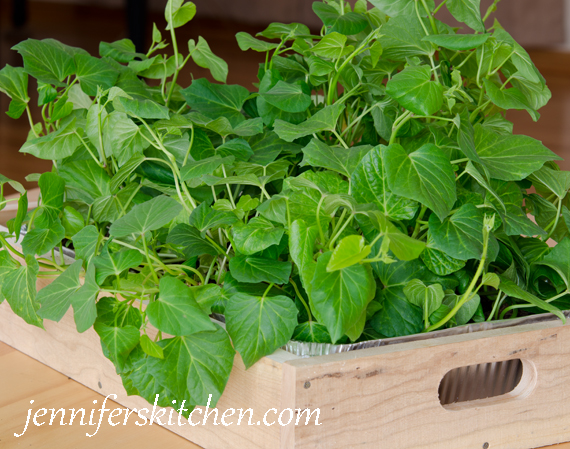
Prepare Garden Spot
When slips are hardened off and the weather is very warm, it’s time to plant.
Form a hilled row (about 12-inches high) in your garden. Sweet potatoes need full sun, so be sure to choose a sunny location. They also need heat, so I always cover my hills with black plastic using dirt to hold down the edges. I know some gardeners – in both cool climates and hot climates – who’ve tried to grow sweet potatoes without the black plastic, but they didn’t have good yields.
Make holes in the plastic about 12 to 18 inches apart along the top of the hill.
Now, gently tug/twist a sprout off the starter sweet potato. The sprout should have several roots on the end of it. Place it in the hole as deep as possible while still keeping the top few leaves above the soil. Be sure roots are covered well with soil. Water well and repeat with the remaining sprouts.
If possible, plant your sprouts on a shady day or at least in the evening, so they don’t suffer too much before they adjust to their new home.
Keep your baby plants watered very well for the first week.
If you live in a cold climate, like I do, you’ll need to cover your sweet potato plants to keep them warm. I recommend using some row cover from Bootstrap Farmer (or something similar).
After that, growing sweet potatoes is pretty much care-free! In my opinion, they give me the biggest yield per time invested of anything I grow in my garden.
In about 90 to 160 days, depending on your variety, your sweets should be ready, and you can dig them up! Sweet potatoes are extremely frost-sensitive, so be sure to pull them before any threat of frost.
Curing
Sweet potatoes need to be “cured” right after harvesting as this will develop their sweetness. No worries; curing is easy. Don’t skip this step though, as fresh, uncured potatoes don’t taste very good and don’t bake well either.
Gently brush off the dirt, and place the tubers in a warm, shaded, well-ventilated place (like in the garage or a very warm room in the house) for about 8 to 10 days.
After they’re cured, they should be stored in cool, dry place at around 50°F to 60°F (don’t refrigerate). We store ours in a room in our basement and they keep for months! In fact, I had one for lunch yesterday, and we are sometimes eating the last few tubers while planting a new crop.
Now you have yummy sweet potatoes all winter long!
More sweet potato yumminess:
You my also like:

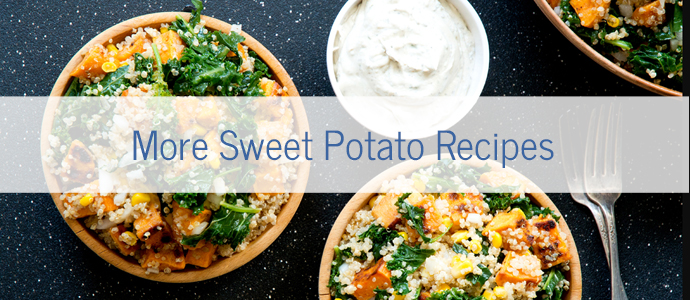

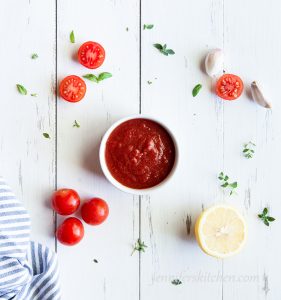

When you place the sweet potato plant in the hole as deep as possible, will some of the leaves end up being covered by the soil? (While still keeping the top few leaves above the soil.)
You can pull off the lower leaves if you want to or you can place the plant in the soil right up to the lowest leaf. Either way works fine.
I can say without a doubt that Jennifer knows what she is talking about. I have had these wonderful sweet potatoes raised by Jennifer and family. Never tasted such SWEET potatoes! But I think she left out part of their family secret. They put a lot of love into their garden; just as they do on this website.
Aw, you are sweet, JoAnn.
Can’t wait to try a Nancy Hall sweet ‘tater! Just ordered 50 starts from http://www.tatorman.com. They are much cheaper than Sandhill, although they don’t have nearly as many varieties.
Thank you for the tater website. Looks like a great source! I’m sure you’ll enjoy! 🙂
I have very large and shady pecan trees that I cannot cut I am going to plant Nancy Halls in my small garden I am determined to grow Nancy Halls. My plot has partial sun due to the pecan trees. Please, please advise me of what I should do to have a successful crop,.
Thank You,
Fred Cooper
Hi Fred,
I’m not sure how well they will do if they don’t get sun all day. A lot will depend on the climate where you live.
You can also increase your chances of success by using black plastic as I described above, and even covering your plants with row cover to keep the heat in.
Best wishes!
Jennifer
Good morning, will I need to continue “hilling” up the soul as the plant grows taller through the season? Thank you, Robin
Hi Robin,
Once planted, the sweet potato plant does not need to be “hilled”. As I mentioned in the post, they actually do best when planted in hills covered by black plastic.
Best wishes to you!
Jennifer
Hello,
I live in Dallas and do get a lot of heat. Do you think its too late to start the slips now since it’s already June? I love sweet potatoes too.
Hi Maria,
I think it is probably too late to start slips now; however, if you can buy some slips already started, it’s not too late to plant them in the garden.
Jennifer
Forgive me, but what is a tuber and how many potatoes does each slip provide?
The sweet potato itself is a root tuber.
The number of potatoes each slip provides varies depending on soil, temperature, water, variety, and other factors … but 7 – 8 is about average for Nancy Hall variety.
Hope this helps 🙂
How often should I water them?
Hi Kimmyg,
We water ours at least once a day (sometimes more) the first day or two after planting them.
After that, we water very infrequently and sometimes not at all – depends on what type of soil you have. The black plastic keeps a good deal of moisture in.
Jennifer
Those fries look great. Is there a recipe link for those? Do you have a trick to get them a bit more dry and crispy?